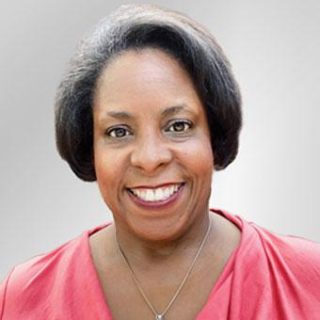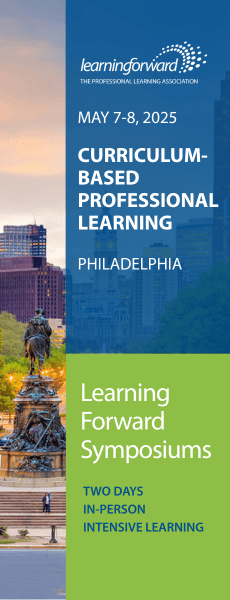SPEAKER SPOTLIGHT
Schools and community programs are stronger together
By Karen Pittman
Categories: UncategorizedOctober 2022
Karen Pittman, renowned expert on youth development, will be a featured speaker at the 2022 Learning Forward Annual Conference on Dec. 6 in Nashville, Tennessee. Her Thought Leader session, “Learning is Social and Emotional and Inequitable,” will address how alignment between schools and out-of-school time providers can reduce inequity and optimize learning and the role professional learning can play in strengthening those linkages.
Pittman co-founded the Forum for Youth Investment, where she was president and CEO until February 2021. She has held leadership positions at many youth development organizations and was a member of President Clinton’s Crime Prevention Council. She has written three books, dozens of articles, and a longstanding column for the youth development publication Youth Today. She is currently a partner at Knowledge to Power Catalysts.
The Learning Professional asked Pittman to preview the themes of her Thought Leader session and share some insights about why and how professional learning leaders should leverage collaboration between school and out-of-school time settings. Questions and responses have been edited for publication.
Pre-K-12 schools and community-based youth programs have developed stronger relationships over the past few decades. Why is that, and why does it matter?
The walls between schools and community programs have been softening steadily over the last few years, fueled by three things: increased parental demand for extracurricular programming, increased local infrastructure and capacity for out-of-school time, and increased emphasis on social and emotional learning in schools, which is an area in which community programs have always excelled.
The pandemic created the potential for turning that evolution into a revolution. During COVID-related closures of school buildings, out-of-school-time became all the time (Pittman, 2020), and community-based programs responded in ways that demonstrated their real value in the broader learning and development ecosystem. Parents and educators got an opportunity to see that these programs are intentionally designed places, staffed with people who are trained and empowered to create relationships and interest-driven learning possibilities. That opens up more possibilities for school and out-of-school educators to collaborate and learn from one another.
How can educators in school and out-of-school time settings learn from one another?
Schools and out-of-school time settings can do much more to design authentic opportunities for their staffs to not only see each other in action but sit together to deconstruct and reflect on what they have seen. This can help them understand different strategies for helping students with learning, connecting, leading, and thriving and open them up to new paths for optimizing learning. It can be challenging to find the time for this collaboration, but schools and community organizations should look for opportunities whenever they can. For example, summer is a natural time for shared programming that brings staff from these two worlds together.
Why is social and emotional learning one of the areas in which you recommend school and out-of-school time educators collaborate?
SEL is the bridge between “taught” and “caught” approaches to learning that epitomize the difference between schools and community youth programs (Pittman, 2022a).
SEL was originally introduced into schools through structured curricula to be taught by teachers at designated times and in explicit ways, where the end goal was to get SEL embedded fully in the school day and school culture. Youth programs, in contrast, focus on building the broader culture and embedded experiences. Students get naturally “caught” in the positive processes of social and emotional growth.
But these approaches aren’t mutually exclusive, and they have gradually come to inform one another. The opportunity for alignment increased when community-based organizations began to introduce training and practices to make their natural learning opportunities more explicit. And conversely, school staff had to prioritize embedding SEL in everyday ways during the pandemic, focusing especially on building relationships, creating space for discussing feelings, and helping students manage emotions and behaviors.
Despite the growth of collaboration between schools and out-of-school time programs, challenges remain. What are some of the collaboration challenges you’ll be discussing at the conference?
Collaboration is always challenging when there is a power imbalance, and the power imbalances between schools and community-based organizations are huge. Equally important, there are power struggles between and within local school systems, which makes it complicated for community organizations that are trying to partner with multiple schools.
Because schools have a lot of power — they have attendance requirements and traditional schedules, large budgets and staff, and defined academic priorities — we have a powerful public idea that associates learning with schooling. But learning is actually a much broader concept, and it occurs in many places outside of school buildings. Decades of research on the science of learning and development challenges the utility of our long-held assumptions that learning only happens at school.
When we consider this research, it should theoretically tip the scales toward the types of learning approaches used by many community programs. These approaches are relationship-based, interest-driven, personalized to young peoples’ needs, and responsive to community needs.
But we have not yet reached the tipping point where schools realize the value of the more flexible community-based learning system and commit to strengthening it and learning from it. It will take public demand to reach the tipping point. Recognition from school-based educators is an important factor.
How can we improve professional learning to address the collaboration challenges?
The Harvard Business School has a formula for predicting the depth and durability of change an organization or system can support: C=DxVxP. Change is equal to the intensity of demand times the clarity of the vision times the specificity of the plan. Too often, professional learning focuses only on the plan, bringing in specific training, curricula, and practices for educators without first engaging them in deep discussions about the vision. We must rethink professional learning to make the changes that honor what we now know about learning and development, thriving, and structural inequalities.
Most importantly, professional learning needs to acknowledge the complexity of the jobs school and community educators have. Educators in all settings need to have foundational knowledge of child and youth development, a deep understanding of the essential elements needed to motivate authentic learning, and an awareness of how they can optimize these elements in the contexts where they work using proven practices. Engagement and achievement go together, regardless of the type of learning content and the setting (Pittman, 2022b). When educators understand how to bring those pieces together, it is possible for all students to thrive.
References
Pittman, K. (2020, March 30). What happens when out-of-school time is all the time? The Forum for Youth Investment. forumfyi.org/blog/what-happens-when-out-of-school-time-is-all-the-time/
Pittman, K. (2022a, August 26). Out-of-school time programs add social and emotional instruction. Changing the Odds Remix. changingtheoddsremix.com/2022/08/26/youth-today-caught-and-taught/
Pittman, K. (2022b, August 29). Raising achievement or engaging students? We don’t have to choose. Changing the Odds Remix. changingtheoddsremix.com/publications/remix-roundup/2022/08/weekly-remix-round-up-829/
Categories: Uncategorized
Recent Issues
BUILDING BRIDGES
December 2024
Students benefit when educators bridge the continuum of professional...
CURRICULUM-BASED PROFESSIONAL LEARNING
October 2024
High-quality curriculum requires skilled educators to put it into...
LEARNING TO PIVOT
August 2024
Sometimes new information and situations call for major change. This issue...
GLOBAL PERSPECTIVES
June 2024
What does professional learning look like around the world? This issue...












